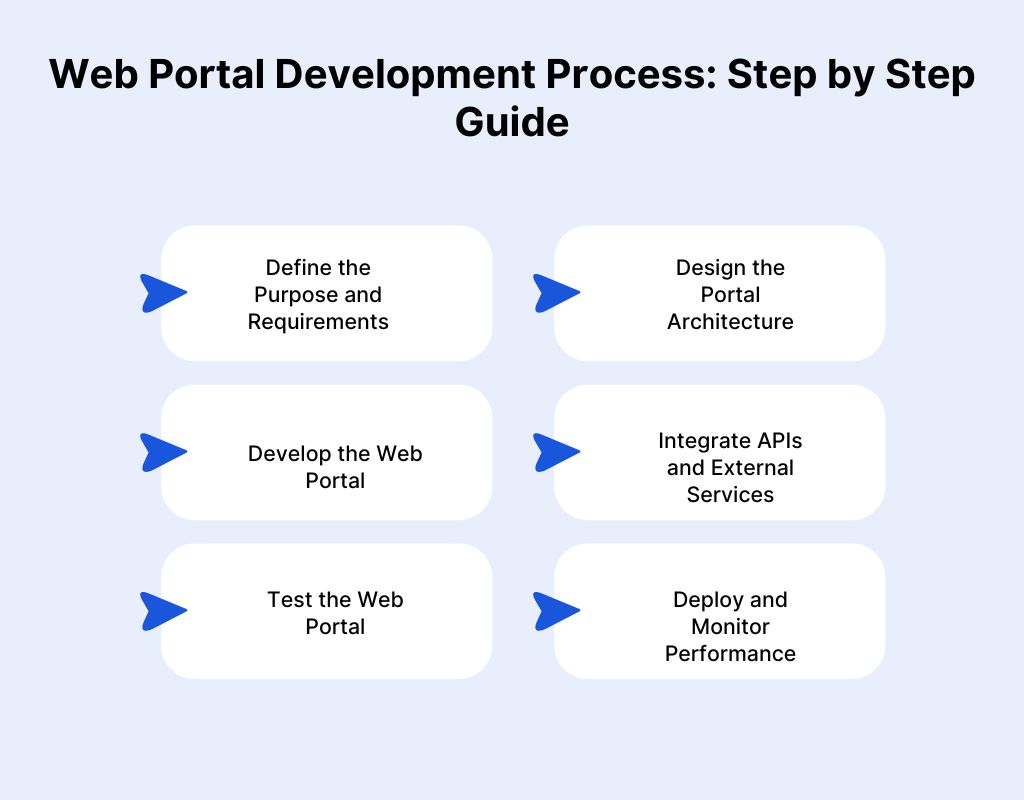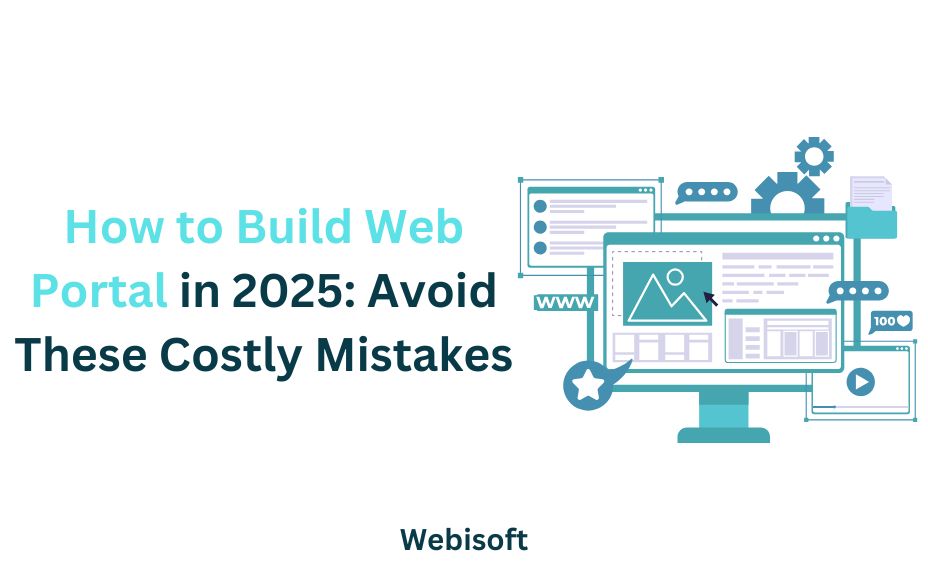In 2025, the global web development market is projected to reach $88 billion. With thousands of new websites launching daily, many businesses struggle with poorly planned web portals. Are you making the same mistakes?
Most people jump into development without a clear strategy, leading to high costs, security risks, and poor user experience. If you want to know how to build a web portal in 2025 and avoid these costly mistakes, you need a structured approach.
This guide will cover why web portals matter, critical planning steps to avoid the expensive attire, a step-by-step development process, and key testing and maintenance practices. Let’s get started.
Contents
Why Should You Develop A Web Portal?
A web portal centralizes operations, improves user experience, and streamlines business processes. It acts as a single access point where customers, employees, or partners can interact, retrieve information, and complete tasks efficiently.
Here are the top 5 reasons why a web portal is essential for any business model.
- Centralized Information: To store and manage data in one place for easy access.
- Better User Experience: To provide a seamless, personalized experience for customers and employees.
- Process Automation: To reduce manual work by automating tasks and workflows.
- Scalability: To expand services and features as your business grows.
- Security & Access Control: To protect sensitive data with secure authentication and user roles.
Skipping web portal development can leave the business disorganized, inefficient, and less competitive.
Planning The Web Portal: Avoid These Costly Mistakes
Many businesses rush into web portal development without a clear plan. This leads to unnecessary expenses, security risks, and poor user adoption. To avoid these mistakes, you must strategically plan every stage.
| Mistake | Impact |
| Undefined Goals | Not setting clear objectives results in a portal that lacks direction and usability. |
| Ignoring User Needs | Failing to research user expectations leads to low engagement. |
| Poor Feature Selection | Overloading the portal with unnecessary features increases costs and complexity. |
| Weak Security Measures | Lack of proper User Authentication Systems makes the portal vulnerable. |
| No Scalability Planning | A rigid structure prevents future expansion and integrations. |
By clearly defining objectives, prioritizing user experience, and focusing on security, you can create a scalable and efficient web portal. Next, let’s go through the step-by-step development process.
Web Portal Development Process: Step by Step Guide

Many businesses start building without understanding Web Portal Architecture, API Integrations, or security requirements, leading to costly mistakes.
If you want a scalable, secure, and user-friendly web portal, you need a structured development approach.
Step 1: Define the Purpose and Requirements
Before you begin, identify your business needs and user expectations. Without clear goals, your portal may lack direction and usability.
Decide whether you need a Custom Web Portal Solution or a pre-built platform. A custom portal offers more flexibility, better performance, and seamless scalability, making it the preferred choice for most businesses.
Step 2: Design the Portal Architecture
A strong Web Portal Architecture is the foundation of a reliable system. At this stage, define the front-end and back-end structure, database setup, and hosting environment.
Choose technologies that support high performance and long-term scalability. Planning the right architecture now will save you from costly modifications later.
Step 3: Develop the Web Portal
Development involves building both frontend and backend components while ensuring security and performance. Implement User Authentication Systems to control access and protect user data.
A well-optimized backend structure, responsive UI, and strong database management will create a seamless experience for your users.
Step 4: Integrate APIs and External Services
A modern web portal needs API Integrations to connect third-party tools like payment gateways, customer support systems, and CRM platforms.
These integrations enhance functionality and improve automation, reducing manual efforts. A poorly integrated system can lead to data inconsistencies and operational inefficiencies.
Step 5: Test the Web Portal
Testing is critical to ensure your portal is secure, fast, and user-friendly. Conduct security audits, usability testing, and performance analysis to detect vulnerabilities before launch.
Ignoring this phase can lead to security breaches, poor user experience, and functionality failures.
Step 6: Deploy and Monitor Performance
Once testing is complete, deploy the web portal in a stable hosting environment optimized for performance.
Set up monitoring tools to track speed, user behavior, and server performance. Regular updates and optimizations will keep the portal secure, scalable, and efficient over time.
A well-planned development process ensures that your web portal is functional, secure, and future-proof.
Testing & Maintenance of Web Portal
A well-developed web portal can fail without proper testing and ongoing maintenance. Many businesses overlook these crucial steps, leading to security vulnerabilities, slow performance, and poor user retention.
The Importance of Testing Before and After Launch
Testing isn’t just for the pre-launch phase. Even after deployment, you need continuous testing to detect security flaws, performance issues, and usability problems.
The business must conduct regular security audits, functional testing, and performance monitoring to ensure the portal runs smoothly. Ignoring this step can lead to downtime, data breaches, and frustrated users.
Ongoing Maintenance for Long-Term Stability
A web portal requires constant monitoring and updates to remain effective. Security updates must be applied regularly to keep User Authentication Systems protected from cyber threats.
Additionally, tracking loading speed, uptime, and server performance helps maintain an optimized user experience. Bug fixes and enhancements should be addressed immediately to prevent issues from escalating.
The next thing is, content updates which are equally important. A portal with outdated information reduces engagement and trust. Keeping the content fresh, relevant, and user-friendly improves usability and ensures visitors return. Without proper maintenance, even the most well-built web portal can become obsolete.
Final Verdict
Building a web portal is more than just writing code. Without proper planning, security measures, and regular updates, your portal can fail.
Many businesses make the mistake of overlooking user needs, skipping scalability planning, or neglecting maintenance. These mistakes lead to security risks, slow performance, and low engagement.
If you follow a structured approach, choose the right technology to develop a scalable and high-performing web portal. Then, it will be easy to avoid costly mistakes and the portal remains secure, efficient, and adaptable to future business growth.
Frequently Asked Questions
1. How do I choose the right hosting for my web portal?
Choose a hosting provider that offers scalability, security, and high uptime. Consider cloud-based solutions like AWS, Google Cloud, or Azure for better performance, flexibility, and automatic scaling as your portal grows.
2. What industries benefit the most from web portals?
Web portals are ideal for e-commerce, healthcare, finance, education, and corporate businesses. They improve customer interactions, automate processes, and centralize data, making them essential for industries handling large-scale user engagement and operational management.
3. How can I improve user retention on my web portal?
Enhance user experience with a clean UI, fast loading speeds, and personalized content. Offer secure authentication, real-time support, and mobile-friendly design to keep users engaged and coming back.
